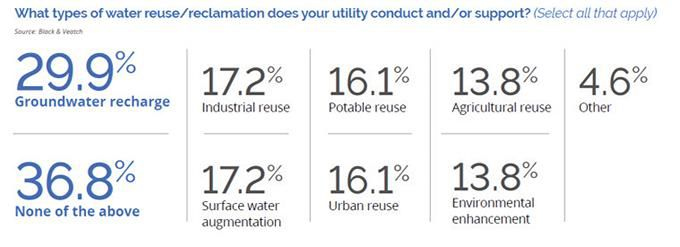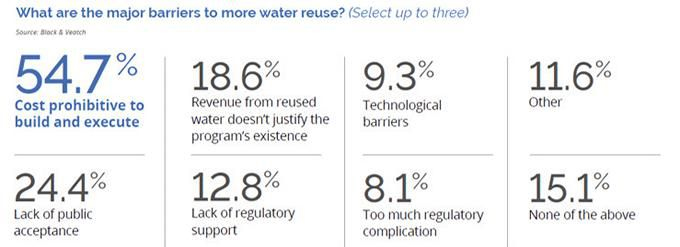More Of A Good Thing: Utilities Prioritize Water Reuse Strategies
By Zeynep Erdal, Jo Ann Jackson, and Andrew Shaw
Black & Veatch’s annual Strategic Directions report reveals the momentum for water reuse in the U.S., citing reasons for uptake as well as remaining barriers to entry.
Faced with the specter of climate change and all its devastating impacts — from increasingly extreme storms to longer and more significant droughts — it’s no longer sustainable to rely on discovering new water resources. Much of the world’s population faces an uncertain water future, making it more imperative than ever that we adopt smart strategies to reuse what we already have.
An expanding portfolio of water reuse strategies is giving water utilities more options when it comes to meeting the needs of growing populations in water-sensitive areas.
Making Reclamation A Priority
Utilities are increasingly adopting water reclamation and recycling strategies to bolster water resilience and reduce effluent discharge. According to the Black & Veatch 2020 Strategic Directions: Water Report survey, which polled nearly 300 water industry stakeholders, nearly six in 10 respondents said water reclamation and reuse are part of their sustainability goals and metrics in their overall water-management plan.

Figure 1. Steps to bolster resilience
This represents a step change, as 65 percent of respondents indicated they are exploring water reuse implementation options more deeply today versus five years ago. When it comes to water resilience, reuse capabilities are the strategy most widely used by smaller utilities. For larger utilities — those serving populations of at least 500,000 — reuse ranks as the No. 2 strategy behind seeking new groundwater sources.
Water reuse means adopting a “circular economy” approach. Two-thirds of survey respondents indicated they are familiar with the core principles of the circular economy. Incorporating these principles into water management and reuse strategies requires analyzing the method that works best based on region and size, bringing the public on board, and finding creative ways to pay for it.
Trends In Reuse Utilization
Groundwater recharge is a means of potable reuse by way of groundwater injection or infiltration to “bank water” for future use. It is widely used in the arid Western United States. A regional breakdown of the survey showed respondents from Western states indicated groundwater recharge was a primary strategy in their water recycling portfolio.
Northeastern utilities picked groundwater recharge, industrial reuse, and urban reuse in an across-the-board tie for their most popular water reuse strategy. Midwest utilities also chose groundwater recharge as the strategy they were most likely to use — with industrial reuse, surface water augmentation, potable reuse, and environmental enhancement tying for second.
In the South — between New Mexico and Virginia — where the largest portion of utilities by region had yet to adopt water reuse strategies, the most popular adopted or supported strategy is potable reuse, including surface water augmentation and groundwater recharge.

Figure 2. Reuse types
Multiple Steps To Bolster Resilience
A regional breakdown of water reuse strategies reveals, especially for larger and more mature institutions, that these utilities are implementing more than one water reuse strategy. While more than 40 percent of respondents chose risk mitigation, resilience, and/or water scarcity as their main reason for water reuse, effluent disposal is also a factor in water recycling strategies. Twenty-eight percent of respondents cited effluent disposal as their main reason for a reuse program.
In the 1960s, Florida began recycling water as a way of mitigating effluent disposal, implementing water reclamation efforts to divert treated effluent for Tallahassee agriculture. By the 1970s, this broadened into reclaiming water for landscape irrigation.
Today, the vast majority of Florida counties continue to reclaim their wastewater. Florida citizens reuse wastewater to irrigate their private and public lawns, and roughly 820 million gallons of reclaimed water were used for public benefit purposes in 2019. As groundwater supplies dwindle, Florida is considering expanding into potable reuse strategies, according to the Florida Potable Reuse Commission’s new strategic plan.
Survey respondents indicated that after groundwater recharge, potable reuse was part of their reclamation use portfolio. Sixteen percent of respondents chose potable reuse as a water reclamation strategy, tying with urban reuse and just slightly less than industrial and surface water augmentation.
Getting The Public On Board
As California learned, a successful potable reuse program hinges on public acceptance. Public acceptance of potable reuse programs, while still a significant factor, appears to be increasing, particularly as engineering and technical advances continue to improve safety.
As the University of California-Davis Policy Institute for Energy, Environment and the Economy reported, California lawmakers looking to meet state requirements for an increase of one million acre-feet of reused water per year by 2020 and two million by 2030 have mandated that treated wastewater be recycled for drinking by 2023.
Even facing historic droughts, initial attempts for potable water reuse in the state failed to gain public acceptance.
In 2008, however, the Orange County Water District of California, in partnership with the Orange County Sanitation District, began a successful groundwater replenishment system treating 100 million gallons per day of wastewater and replenishing local drinking water aquifers. Bolstered by a decade of public education, engagement, and smart engineering, and building on expertise in water recycling going back to the Water Factory 21 project, the district found media coverage positive and public support widespread.
The final expansion of that system is in construction, taking the total capacity from 100 million to 130 million gallons per day. The system has recycled more than 314 billion gallons since inception, and on its 10th anniversary set a Guinness World Record for the most wastewater recycled to drinking water in 24 hours.

Figure 3. Barriers to reuse
Challenges To Reuse Efforts
Survey respondents indicated the biggest barrier to more reuse is cost. In a survey question asking respondents to select up to three barriers to doing more reuse, costs to build and execute were the biggest obstacle. Lack of public acceptance was still significant but less than half that of the barrier of costs. Revenue from reused water systems was also considered a barrier, ranking as the third-most significant barrier to implementing reuse strategies.
Cost was an even greater factor for utilities serving fewer than 500,000 customers. Lack of public acceptance was almost twice as likely to be selected by larger utilities than smaller ones. Both groups similarly selected insufficient revenue from reused water systems to justify the programs. Investment in water reuse can, however, offset other water utility costs when approached in a holistic framework.
Utilities may be unaware of increasing grants to offset water reuse investments as federal and state legislators begin embracing water reuse.
In February 2020, the U.S. EPA released the new National Water Reuse Action Plan. Focused on water reuse as “a valuable, perhaps necessary component of integrated water resources on planning to ensure safe and reliable sources of water at the federal, state and local levels well into the future,” the report includes a compilation of federal funding sources.
Searching for new resources, aggressively asking potential partners for help, plus positioning for grant funding and stimulus money for shovel-ready projects are smart strategies for utilities looking to invest in water reclamation projects.
Black & Veatch’s survey results reveal an increasingly positive outlook for water reclamation as a real solution for overall resilience efforts. Reuse is a wise water utility strategy in a world increasingly adopting a circular economy framework as the answer for future sustainability and resilience
About The Authors

Zeynep Erdal leads integrated solutions for Black & Veatch, where she specializes in “One Water” solutions that integrate resource recovery and resilience. With close to 25 years of experience in water reclamation projects around the world, Erdal is a recognized expert in treatment technologies focusing on the water-nutrient-energy nexus and the integration of used water and water recycling solutions.

Jo Ann Jackson leads Black & Veatch’s national “One Water” planning practice. With more than 35 years of experience developing integrated solutions to wastewater, stormwater, and water supply projects across the U.S., Jackson spent six years in the public sector, where she helped implement Florida’s first direct potable reuse pilot and served as a utility representative on Florida’s Potable Reuse Commission.

Andrew Shaw is a global practice and technology leader in sustainability and wastewater for Black & Veatch. He has more than 25 years of experience in wastewater treatment design projects around the world: in the United Kingdom, Australia, Asia, and North America. His expertise includes nutrient removal, computer modeling, instrumentation, process optimization, and lifecycle assessments.
